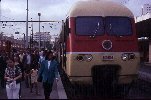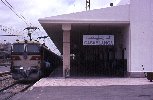



by Jim George
As printed in the January 1999 Northstar News
In June of 1998 our family left for a 3-week trip to Morocco, Spain, England, and Scotland. Our older son Mark joined the Peace Corps and was assigned to Morocco the year before, so we had been planning for some time to visit him while he was there. We wanted to do this as a family so we could include our younger son Ryan, and as a result of his interest in the Mel Gibson movie Braveheart we also decided to add a short visit to Scotland. In between we would pass through Spain and England (Cornwall). Probably a bit too ambitious for the time we had but it would most likely be a once-in-a-lifetime venture and we wanted to try to accommodate everyone.
Morocco is in the northwest corner of Africa directly across the Mediterranean from Spain. The original people there were the Berbers but the Arabs later moved in from the east and became the dominant cultural influence. During the colonial period the country came under the influence of the Spanish, Portuguese, and French; later it became a French protectorate in the early 1900's, and finally gained its independence in 1956. Today it is a constitutional monarchy under King Hassan II. Arabic is the official language but French is the everyday language of government and tourism. Islam is the official state religion. The country is relatively stable, safe, and caters to foreign tourists.
And there is a railroad system there, a surprisingly good railroad system. When I found their web site on the Internet (www.oncf.org), that should have been my first clue. Even though their site is in French I was able to navigate through it to print up schedules and get fare information. Prices are very economical and reflect what an overall travel bargain tourists will find in the country. Local currency is the dirham, worth about 10 cents.
Thanks to Northwest Airlines and subsequent missed connections in Amsterdam we arrived in Casablanca about 1:00 a.m. instead of the originally scheduled 4:00 p.m. the afternoon before. (But I guess we were "fortunate." Coming home they got us back 12 hours late!) At that late hour Mark, who was going to meet us at the airport, had given up and gone back to the hotel. By the time we were able to change some money, hire a taxi, find his hotel, and finally get to sleep it was 3:00 a.m. We had to be up at 6:00 a.m. to catch a morning train to Marrakesh, one of the country's four imperial cities.
Some of you may remember the old Crosby, Stills, & Nash song about riding the Marrakesh Express. Well, there is an actual named train called Marrakesh 1 although we didn't ride it. We took an earlier train simply numbered V1601. All passenger trains are either numbered or named, frequently for the destination city. From Casablanca to Marrakesh is about 140 miles by rail; Marrakesh is the southern end of the system. Southeast of there lie the Atlas Mountains which effectively block any railroad building beyond that point.
The Moroccan national railroad system (ONCF) is standard gauge, mostly electric with some diesel activity associated with the freight business. The system links the major cities of the country including Marrakesh, Casablanca, Rabat (the capital), Meknes, Fez, and Tangier. There is a line east from Fez which goes on to Algeria. There is passenger service to all these cities but there are also other branches to parts of the country which are identified as industrial railroads with no passenger service. Future new construction will add additional miles to the system in the next few years. Main freight business appeared to be phosphate, grains, petroleum products, and some container freight. Surprisingly, there are no significant reserves of oil in Morocco but there is some refining activity.
The passenger aspect of the system is quite impressive. There are two kinds of passenger trains, what they call "ordinaire" and "a supplement," as well as first-class and second-class on each. We chose the first class on "a supplement" (faster) trains because the fares were so cheap. The 140 mile trip to Marrakesh cost us about $10 each. Later on we did a longer trip from Marrakesh to Fez, 330 miles, that cost about $23 each. The trains are reasonably new, clean, and comfortable. The first class cars are compartmentalized with the hall on one side of the car and the compartments on the other. Each compartment has 6 large seats, its own door, and is air conditioned. Smoking is not permitted in the compartments but is in the hallway and vestibules. There are no dining cars but they do have cart service that comes around and sells drinks, snacks, and sandwiches. We took food along with us on most trips preferring to buy bread or rolls, jam, fruit, and cookies in town the night before.
Track is all welded rail with concrete ties, very smooth, and train speed reaches the 70-90 mph range from what I could estimate. Passenger trains receive priority and the few freights we did see were tucked away on passing sidings as we went by. It is a single track system but in most small towns along the way there are passing sidings, as much for meeting other passenger trains as well as for overtaking freights. The trains run frequently and on time, much in the European tradition. On the several trips we took departure times were prompt, station stops were brief, and there was none of this creeping along or frustrating unscheduled, unexplained stops in the middle of nowhere that we are so likely to find here in this country.
Especially impressive are the stations along the line particularly in the major cities. They seem to be fairly new, clean, bright, and incorporate a number of interesting architectural features such as clock towers, arches, large platforms, mosaics, marble, and tile. There are usually gardens with flowers and orange or banana trees nearby or on the track platforms. Even in the smaller towns the stations are clean and well kept, often whitewashed with tile roofs.
We saw a lot of the country by train. After our first day's trip to Marrakesh, we did rent a car for 3 days so that we could cross the Atlas Mountains and drive to my son's village, Tazarine, where he is stationed. After that we drove back to Marrakesh and took an all-day train to Fez by way of Casablanca and Rabat. After two days in Fez we left again by train west through Meknes to the junction at Sidi Kacem where we caught another train north to Tangier.
Much of the countryside reminded me of travelling through parts of the Dakotas and eastern Wyoming or Montana with the semi-arid landscapes, corn and wheat fields, irrigation, hay bales and familiar sights. But when we passed through all the little villages with their mosques and minarets where the call to prayer occurs 5 times a day - we realized again where we actually were. However we saw no evidence of any anti-American sentiment while we were there. We always felt comfortable and safe, never felt threatened in any way, and were warmly received as house guests by a couple of local families in Mark's region where we were invited for dinner. More recently though since the American missile attacks in Sudan Mark has told us that he kept a low profile for a few days just to be on the safe side.
Tangier was our jumping-off point for leaving Morocco. The next morning we left by ferry for a 2 1/2 hour ride across the Straits of Gibraltar to Spain where we were to continue with the rest of our trip. We eventually rode the Spanish high-speed AVE trains from Seville to Madrid and then later on in England and Scotland we traveled on 8-day Britrail Passes. But those trips are another story for a later time. Suffice it to say I did take quite a few pictures of the entire trip and am in the process of putting a slide program together for presentation in the near future. While not quite qualifying for "Great Railway Journeys of the World" status I'm sure you'll find it to be at least an interesting railway journey.
v990111